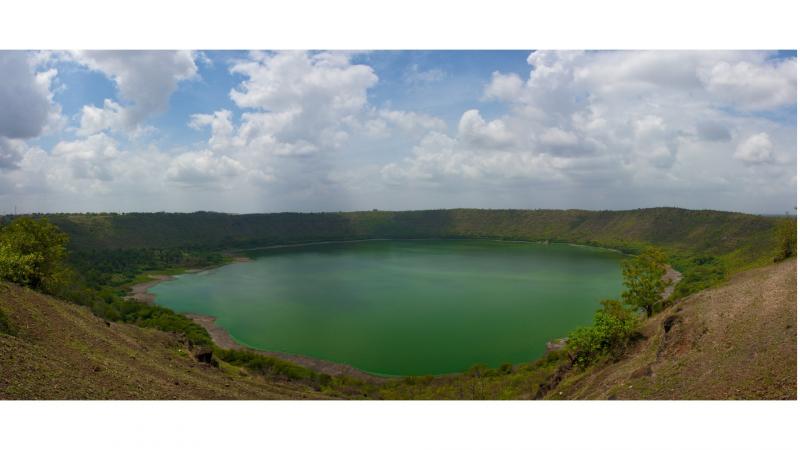
Analysis of soil samples from the Lonar crater lake indicates the presence of extra-terrestrial rocks
As a child, did you look at a shooting star and make a wish? By now you know that shooting stars are actually meteors---broken pieces of celestial bodies such as asteroids and comets---that enter the earth’s atmosphere. Most of them burn off, but occasionally a large one hits the earth’s surface and forms a depression or a crater; Lonar lake in the Buldhana district of Maharashtra is an example. Researchers from Indian Institute of Technology(IIT) Bombay, Dr Babasaheb Bhimrao Ambedkar Government Polytechnic Karad and Archaeological Survey of India, Aurangabad studied soil from the Lonar lake and found that the materials from the meteor had a significant impact on the native soil.
Studying the soil from a meteor crater could help in tracing the changes in the soil, during and after the impact, because of the enormous temperature and pressure changes. The presence of various chemicals and minerals could help us understand how the local ecosystem was affected during this time and how it is recovering.
“The (meteor) impacts (like this) are the only extra-terrestrial mechanism capable of causing localized ecological disturbances”, comments Prof. D N Singh, Institute Chair Professor, Department of Civil Engineering, IIT Bombay and the lead author of the study.
The Lonar crater formed approximately 50,000 years ago is one of the only two known natural craters formed entirely in basalt---a dark, fine-grained volcanic rock---and is analogous to the basaltic crust on Mars.
“The study of the structural geology of the crater would throw light on the impact deformation process that takes place on a terrestrial planet”, explains Prof Singh. The basalt absorbed the shock of the impact and instead of the meteor penetrating deep inside, a molten mass of rock flowed out of the crater forming a continuous blanket. This blanket is preserved well and can be used to study the different models for this deformation phenomenon.
The research team collected soil and water samples from three different regions of the bowl of the crater and the lake and measured their alkalinity, amount of salts, organic content (nitrates and phosphates) and other chemicals present, and the particle size. They also studied the physical, magnetic and electrical properties of the soil.
The composition of the soil itself is of significance because certain heavy metals, minerals and salts found in the soil at the impact sites are an important group of environmental pollutants, dangerous for humans and water creatures.
The researchers found the Lonar crater soil is denser than the normal soil, indicating the presence of heavy metals like iron and titanium. The samples near the periphery of the bowl of the crater were more porous and had a lesser amount of fine material compared to the samples near its centre. The researchers attribute this to fine material washing away towards the centre due to rain.
The chemical analysis showed that the soil samples have a high iron content, similar to samples from other meteor impact sites. The higher than usual content of aluminium and titanium resembles the moon rock samples (from the Apollo 11 and Apollo 14 missions). The Lonar soil has a higher content of dissolved salts of sodium and magnesium making the lake water salty.
Researchers found diopside, albite, pigeonite, and anorthite---minerals having a resemblance to the moon rock---in the Lonar lake soil samples. Though pigeonite may be present in basalt rocks, the mineralogical analysis matched the moon rock. In spite of the samples containing a high amount of silica, the silica mineral quartz is absent. Though this peculiar phenomenon could occur due to the absence of quartz in the original rock before impact, it is also possible that the quartz melted due to high temperature during the meteor impact.
The researchers found intact fragments of rocks in the samples and were able to identify them as native or extra-terrestrial (originating from the meteor). White coloured deposits on the rocks indicated a prolonged reaction between the rocks and water after the impact. The native soil was more crystalline in nature and rich in hydrogen, nitrogen, sodium, calcium and magnesium.
“Normal soil would have high amounts of organic compounds and lesser content of iron and aluminium whereas the meteor impacted soil has no organic compounds and a higher content of iron and aluminium. We found nickel, platinum, iridium and cobalt abundantly only in the meteor impacted soil. The presence of sodalite, which is not common in a normal environment, probably indicates a possible hydrothermal event (circulation of hot water) that could be linked with the meteorite”, says Prof. Singh.
The study points to the interaction of extraterrestrial and native rock during and after the meteor impact. Findings of the study further confirm the meteoric origin of the Lonar crater, which is one of its kind in South East Asia and has its twin in Arizona, USA.
“Certain aspects, that point to a hydrothermal event, have to be established by studying several samples collected from the crater”, concludes Prof Singh.
Editor's note: This article was edited because of a typo. The mistake is regretted.






